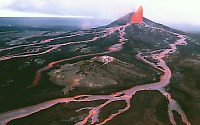
|
|
Volcanic Hazards on the Island of Hawai`i |
Ever since lava first erupted above sea level over 500,000 years ago to begin building the Island of Hawai`i, countless eruptions from its five volcanoes have built the "Big Island" to a towering height of more than 4,000 m (13,000 ft). Its two most active volcanoes -- Mauna Loa and Kilauea -- erupt lava frequently enough to pose a serious hazard to property on many parts of the island. About 40 percent of Mauna Loa has been covered by lava in the past 1,000 years and over 90 percent of Kilauea's surface is covered by lava less than 1,100 years old. As land development expands toward areas of relatively high hazard, the threat to life and property on Hawai`i will increase accordingly.
Types of Volcano Hazards at Hawaiian volcanoes
-
The following hazards are described in the USGS publication,
Volcanic
and Seismic Hazards on the Island of Hawai`i,
revised and reprinted in 1997:
- lava flows
- tephra (airborne lava fragments)
- volcanic gases
- explosive eruptions
- ground cracks and settling
When lava meets the sea
-
New land the size of several football fields can collapse into the ocean with little or no warning, and the intensity of lava-seawater explosions can change suddenly. Find out how new land is created when lava enters the sea and how to identify areas near lava-entry points that are safe for viewing.
Lava-flow hazard zones on the Island of Hawai`i
-
Hazard zones from lava flows are based chiefly on the location and frequency of historic and prehistoric eruptions and the topography of the volcanoes. Scientists have prepared a map that divides the five volcanoes of the Island of Hawai`i into zones that are ranked from 1 through 9 based on the relative likelihood of coverage by lava flows.
Hazards Posed by Volcanoes
-
Illustrations, descriptions, and animation of hazards posed by volcanoes worldwide, including tephra, lahars, lava flows, pyroclastic flows, landslides, and volcanic gas.
Contact: hvowebmaster@usgs.gov
Updated: 18 June 2001 (pnf)

 Zones
Zones


